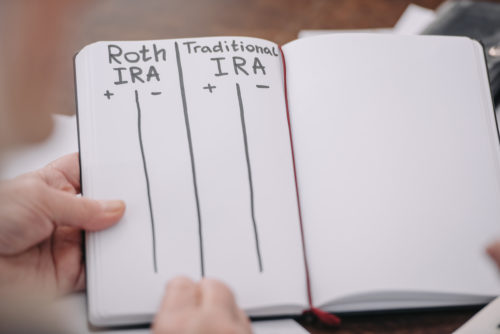An individual retirement account (IRA) allows you to make contributions towards your retirement while taking advantage of certain tax breaks. There are several types of IRAs. The most popular IRAs are the traditional and Roth. Take a closer look at the differences and how you can convert a traditional IRA to a Roth.
Table of Contents
Traditional IRA vs. Roth IRA
In both types of IRAs, you’ll get tax breaks. The main difference comes down to when. In the case of a traditional IRA, you’ll get a tax deduction now and pay taxes later at retirement, when you withdraw the funds. A Roth IRA gives you the tax break at retirement when you withdraw the funds, but you’ll need to pay taxes on the contributions now.
There are other key differences you should consider before deciding on which IRA is best for you:
- Taxable earnings: A Roth IRA’s earnings grow tax-free, while a traditional IRA’s earnings will be taxable upon withdrawal.
- Required minimum distribution (RMD): The traditional IRA requires you to stop contributions and start withdrawing funds annually once you’re 70½. You may leave your Roth IRA untouched and keep funding it as long as you’d like, although you can make qualified withdrawals as soon as 59½ years old if at least five years have passed since you started contributing.
- Penalties: Withdrawing funds early will cost you a 10% penalty. For a traditional IRA, the penalty is based on the total amount of the withdrawal (including contributions and earnings). For a Roth IRA, the penalty is only charged on the earnings portion of your withdrawal.
- Withdrawal qualifying reasons: There are times when you can withdraw the earnings from your Roth IRA penalty-free before you retire. They include paying college expenses for you or your immediate family, including your spouse and grandchildren, or using up to $10,000 to buy a home for the first time.
There are several factors to consider when preparing for retirement. If you go with a Roth IRA, you’re using after-tax dollars to contribute to your retirement fund. Follow the rules, and your investment earnings and withdrawals down the road will be tax-free. Traditional IRA contributions are made with pre-tax dollars and you’ll pay tax on the contributions and earnings when you withdraw the funds during retirement. For most individuals, a Roth IRA is the smarter and more flexible choice.
Roth IRA Conversion Methods
Roth IRAs are a fairly recent retirement product. They were introduced as part of the Taxpayer Relief Act of 1997. Many investors were contributing to a traditional IRA or 401(k) until the Roth IRA came along. Fortunately, investors can do a Roth IRA conversion to benefit from tax breaks at retirement. Here’s how to shift money from a traditional IRA into a Roth IRA:
Rollover
To complete a Roth IRA conversion rollover, you’ll need to open a Roth IRA and pay taxes on the rollover amount. Depending on the amount you wish to roll over, your next tax bill may be larger than usual, so consult with a retirement or tax professional before converting your IRA. Most financial institutions have rollover specialists on hand to offer help with the Roth IRA conversion process.
Trustee-to-Trustee
A trustee-to-trustee conversion is also known as a direct rollover. The funds go from your traditional IRA account to your Roth IRA directly and electronically. All you need to do is tell your traditional IRA provider to disburse your funds to your Roth IRA account. Besides the ease of the trustee-to-trustee transfer, you can make as many transfers as you wish.
The opposite of the trustee-to-trustee rollover is the indirect rollover, where you’ll receive a check for the amount you wish to transfer. Mishandling the process can land you in hot water. Once you receive the check, contribute the total amount to your Roth IRA as soon as possible. The IRS gives you 60 days from the date you receive your distribution to fund your Roth IRA. Failing to deposit the distribution amount within the 60-day limit could be considered an early withdrawal and cost you a 10% penalty.
Same-Trustee
If both of your IRA accounts are with the same financial institution, you can request a same-trustee transfer. Same-trustee rollovers are the easiest way to convert from a traditional to a Roth IRA.
IRS Conversion Rates
When you convert a traditional IRA to a Roth, you’ll need to pay taxes on the amount you plan on rolling over. The contribution amount is added to your gross income for the tax year and could drive your tax bill up considerably.
Expect to pay 22% on the conversion amount if you earn over $40,125 and are filing individually or $80,250 filing jointly. The rollover amount may even push your annual income into a higher tax bracket, making you liable for a 24%, 32%, or 35% tax rate, so it’s best to be careful and consult with a tax professional before you decide on the amount of your Roth IRA conversion.
Benefits of a Roth IRA
If you’re weighing the pros and cons of investing in a Roth IRA, consider these benefits:
- Early penalty-free withdrawals of earnings for certain situations such as paying for college for immediate family members;
- No required minimum distributions or withdrawals after a certain age;
- Tax-free growth;
- Tax-free withdrawals of contributions at any time.
Drawbacks of a Roth IRA
Roth IRAs come with pitfalls, including:
- No tax breaks on contributions today — you’ll pay taxes upfront;
- A Roth IRA conversion can be expensive since you’ll need to pay ordinary income taxes on the amount you’re converting;
- You can only contribute up to $6,000 per year, or $7,000 per year if you’re 50 or older.
Image Source: https://depositphotos.com/





